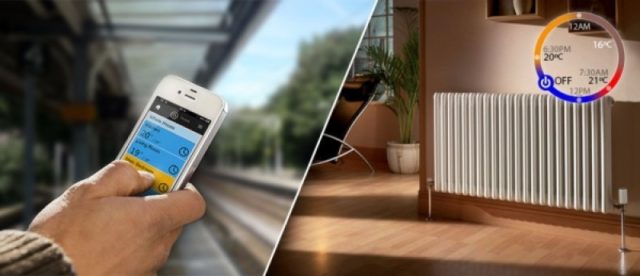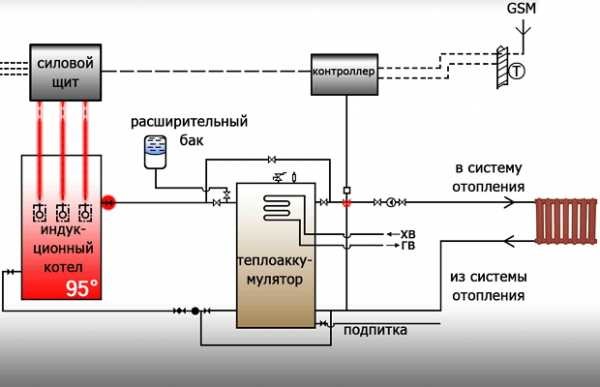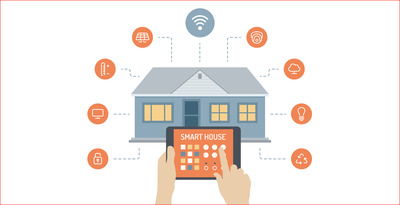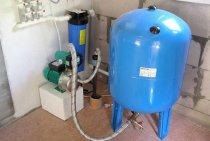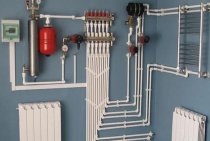GSM MODULES FOR HEATING CONTROL AND CONTROL
Among all the equipment for providing remote control of heating, a GSM module should be highlighted. As already mentioned, it collects information from heating devices, transmits it to the user and receives instructions from him. The efficiency of the entire Smart Heating system depends on the correct choice of the GSM module.
So, pay attention to how many GSM module supports thermal sensors. It is logical that the more zones you are going to monitor, the more sensors you need.
Specify in what temperature ranges it can operate. Modules that can work in conjunction with various security sensors and alarms look much more interesting, but they also cost more.
Choose models that have an autonomous power source
Pay special attention to the number of rooms from which heating can be controlled. Increasingly, there are devices with a variety of capabilities, for example, GSM alarms, but not every user needs them.
If a system for boilers is purchased, then look for a special mark. For a complete system, you will have to separately purchase the relay and the necessary sensors (often included).
If we talk about examples of systems, then first of all it is worth dwelling on the solutions of "Ksital" of domestic production. These are universal GSM blocks that are perfect for the implementation of control systems and remote control of heating.
They do not have a beautiful design, but this is not the main thing in such devices. But Xital has a couple of interesting features. Firstly, the systems support work with two SIM-cards - the money on one has run out, the other is included in the work. Secondly, Xital received its own GSM signal jamming protection system.
The system has all the necessary connectors for connecting various equipment, if you plan to use it with a boiler, then look for a model with the prefix "T". The cost of "Ksital GSM" ranges from 6,000 to 10,000 rubles.
Another high-quality GSM module is the Sentry system, also made in Russia. In general, it is not much different from Xital. Performs all the same functions, has a number of features that will make control and management even easier.
For example, the system allows you to connect, in addition to heating, other subsystems (fire alarms, video surveillance, etc.). It has a special application for smartphones, providing convenient control, there is a line specifically for boilers. The price is about the same - 6000-8000 rubles.
2010-2019. All rights reserved.
The materials presented on the site are for informational purposes only and cannot be used as guidance documents.
GSM heating control scheme smart home
Usually the system can be installed independently. This requires checking the status and analyzing the capabilities of existing equipment.
It is also important to correctly select the missing components. Usually, a set of control devices is built from a single block, which is the link between all components of heat supply.
Control systems based on coolant temperature control operate regardless of current conditions
It must be installed under the following conditions:
- The control unit must be located at a distance of no more than 300 meters from the user. To increase the distance, radio-controlled modifications are purchased, coordination is connected via the Internet or a cell phone.
- The use of a controller based on heat supply management boards allows the installation of additional functions.
- A careful selection of the location in the house for the installation of the control unit is carried out.
REMOTE HEATING CONTROL
In order for the Smart Heating system to work accurately and efficiently, it is extremely important to correctly implement the remote control. At short distances, special remote controls and radio communication are used, with which you can adjust the heating while being directly in the room or nearby
How to organize heating control over long distances?
To a beginner, such a system may seem very complicated, but in reality everything is quite simple and cheap. So, remote control of electrical heating appliances (convectors, infrared heaters, etc.) is implemented using the following components:
- GSM module;
- relay module;
- temperature sensors.
The GSM unit is required to receive commands from the user via a SIM card, which is subsequently installed. The owner of the house sends an SMS message from his mobile phone, which indicates the command to turn on / off, request information or other settings. The module itself, having collected information from other equipment (sensor), can send it to the user.
The relay expander is required to turn on / off the heating appliance, after receiving commands from the GSM module, which receives instructions from the user. Some models of relay blocks allow you to connect several devices at once. On sale there are solutions with a built-in Bluetooth interface, which allows you to control heating from a smartphone on which the application is installed.
Sensors are needed to control the current temperature. They connect to the GSM device, transmitting data. In the event of a sudden change in temperature, information will be sent to the phone, and the owner will be able to choose further actions. The cost of temperature sensors is low, and many models have additional features, such as humidity measurement.
A set of components from a relay, a GSM module and a temperature sensor, as a rule, is enough to organize a simple remote control of electrical appliances. Here everything is tied to electricity, in the event of a shutdown of which the user will be notified.
Features of use in a private house
Their presence is explained by the fact that two-pipe systems are used in such buildings. In them, the circulation pump pumps liquid, which is supplied through the distributor to each heater.
Photo 1. A possible heating scheme for a private house from an induction boiler with a controller.
In such cases, a safety block is used with the controller to protect the heating system from various emergency situations. And also additional sensors for adjusting the flow of liquid (coolant), special valves are used.
In the house, you can use thermostatic valves or room temperature controllers. The first allows you to set the desired mode to any source, and the second is responsible for the operation of the pump that supplies the coolant to the radiator.
If there is no Internet in a private house, then a GSM module is used, which allows you to control the situation via a smartphone.
How to connect the controller to the heating boiler with your own hands
Pay attention to the nuances when installing the controller:
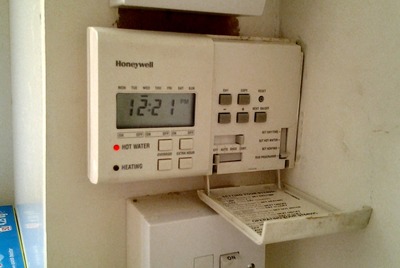
- avoid its contact with direct sunlight;
- isolate from all electrical appliances;
- carry out the process at a height of at least 1.5 m from the floor;
- provide a constant air flow, avoiding drafts.
The controller with your own hands can be connected in two ways:
- using the terminal on the boiler;
- using the regulator cable.
Important! Such a process should not be carried out in the kitchen or in the bathroom, because due to a possible increase in temperature, malfunctions of the thermostat are permissible. Almost every boiler has special contacts for connecting a controller to it.
You need to find this place and remove the jumpers and connect the thermostat. How to set up the device itself and start its operation is indicated in the instructions.
Almost every boiler has special contacts for connecting a controller to it. You need to find this place and remove the jumpers and connect the thermostat. How to set up the device itself and start its operation is indicated in the instructions.
BOILER CONTROL BY GSM
The remote control of boilers, whether gas or electric, is implemented somewhat differently. Here we are dealing with a coolant, which provides a certain temperature in the home. As a rule, water is used for these purposes, less often - antifreeze, ethylene glycol and more.
Please note that for the most efficient use of the GSM node, a digitally controlled boiler is required.
As a result of stopping the operation of the boiler, there is a high probability of defrosting the system, which entails undesirable consequences. In addition, pipes can be damaged, which will lead to flooding of the premises.
Therefore, it is extremely important that the user receive notifications when the boiler is turned off.
Based on this, it is necessary to implement control of the supply of gas or energy and the state of the temperature of the coolant. In general, you can save money by installing boiler equipment comparable to what was described just above, adding only a thermometer to measure the water temperature. By setting an algorithm for maintaining a certain temperature, the owner will be notified if it drops sharply - which means something is wrong with boiler or gas/electricity supply.
However, it is recommended to purchase special solutions for boilers (they are usually marked) in order to be aware of any change. This may include various sensors, such as carbon monoxide, alarms on the presence or absence of gas / electricity, you can even purchase a pressure sensor.
It is advisable to use an autonomous power source in order to receive information about the operation of the boiler during power outages. Advanced solutions can detect leaks and boiler failures.
Purpose of the controller
This unit belongs to the "smart home" functionality. The main tasks with which he copes are distinguished:
- taking readings and uninterrupted operation of the temperature regime of the liquid in the hot water and heating circuits;
- control of the temperature of the direct and return fluid in the heating circuits, protection against its overheating;
- determination of pressure in the heating circuit;
- assessment of the state and location of valves;
- measurement of the temperature indicator of the outside air according to the criteria day/night and winter/summer;
- response to a possible emergency and transmission of notification to an external alarm;
- receiving data from a PC in order to change the information on the sensors;
- storage in memory of the set parameters in case of interruptions in the operation of the voltage supply;
- formation of control signals for hot water supply elements and heating systems;
- setting the necessary parameters using the built-in control keyboard;
- protection of received data from external industrial interference;
- output of control results on LCD;
- the ability to manually control the functioning of the system;
- stopping the heating process for the summer period.
Conclusion
The line of this product is represented by a large number of species diversity of products at a variety of prices, the description of each of which is easy to find on the Internet. Depending on the requests and the financial component of the buyer, there is the option he needs, which in the future will become a reliable assistant in the issue of safe home heating.
Capabilities of heating system controllers
Modern heating systems should provide comfort in the house and reduce energy costs.
The easiest way to solve the problem of controlling the air temperature in a room is to install programmable room thermostats. However, as a rule, this method allows you to effectively control the temperature in only one "master" room. To solve the problem of independent temperature control in several rooms, it is necessary to use heating system controllers.
The word "controller" in translation from English means "control device". The name of the device really reflects its main function. Controllers allow you to effectively control the operation of various devices in the heating system. Receiving information from temperature sensors or thermostats, the controllers allow you to change the operating modes of the heating boiler, circulation pump, distribution devices.
The controller processes incoming data from sensors or thermostats in accordance with a given program, analyzes the received data and sends a control signal to the actuator drives. The drives, in turn, open or close the valves for adjusting the flow of the coolant in a given direction. The controller also controls the operation of the heating boiler and the circulation pumps.
Modern heating controllers allow you to provide:
- accurate and efficient temperature control;
- reduction of energy costs;
- separate regulation of air temperature in different rooms of the house;
- the possibility of individual programming of heating schedules in each room by connecting programmable thermostats.
